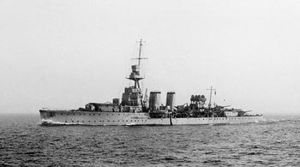 | |
| History | |
|---|---|
| Name: | HMS Curlew |
| Builder: | Vickers Limited, Barrow in Furness |
| Laid down: | 21 August 1916 |
| Launched: | 5 July 1917 |
| Commissioned: | 14 December 1917 |
| Fate: | Sunk by air attack, 26 May 1940 |
| General characteristics (as built) | |
| Class and type: | C-class light cruiser |
| Displacement: | 4,190 long tons (4,257 t) |
| Length: |
|
| Beam: | 43 ft (13.1 m) |
| Draught: | 14 ft 8 in (4.47 m) |
| Installed power: |
|
| Propulsion: | 2 × shafts; 2 × geared steam turbines |
| Speed: | 29 kn (54 km/h; 33 mph) |
| Complement: | 460 |
| Armament: |
|
| Armour: |
|
HMS Curlew was a C-class light cruiser built for the Royal Navy during World War I. She was part of the Ceres sub-class of the C class. The ship survived World War I to be sunk by German aircraft during the Norwegian Campaign in 1940.
Design and description
The Ceres sub-class was redesigned to move one of the amidships guns to a superfiring position in front of the bridge to improve its arcs of fire. This required moving the bridge and tripod mast further aft and rearranging the compartments forward of the aft boiler room. The ships were 450 feet 6 inches (137.3 m) long overall, with a beam of 43 feet (13.1 m)[1] and a mean draught of 14 feet 8 inches (4.5 m). Displacement was 4,190 long tons (4,260 t) at normal and 5,020 long tons (5,100 t) at deep load. Curlew was powered by two Parsons steam turbines, each driving one propeller shaft, which produced a total of 40,000 indicated horsepower (30,000 kW). The turbines used steam generated by six Yarrow boilers which gave her a speed of about 29 knots (54 km/h; 33 mph). She carried 935 long tons (950 t) tons of fuel oil. The ship had a crew of about 460 officers and other ranks.[2]
The armament of the Ceres sub-class was identical to that of the preceding Caledon sub-class and consisted of five BL 6-inch (152 mm) Mk XII guns that were mounted on the centreline. One superfiring pair of guns was forward of the bridge, one was aft of the two funnels and the last two were in the stern, with one gun superfiring over the rearmost gun. The two QF 3-inch (76 mm) 20-cwt anti-aircraft guns were positioned abreast of the fore funnel. The Ceress were equipped with eight 21 in (533 mm) torpedo tubes in four twin mounts, two on each broadside.[2]
Construction and career
She was laid down by Vickers Limited on 21 August 1916, and launched on 5 July 1917, being commissioned into the navy on 14 December 1917. In common with most of her sisters Curlew was rearmed to become an anti-aircraft cruiser in 1935–36. On the outbreak of war she served with the Home Fleet. She participated in the Norwegian Campaign, and whilst operating off the Norwegian coast on 26 May 1940, she came under attack from German Ju 88 bombers of Kampfgeschwader 30 and was sunk in Lavangsfjord, Ofotfjord near Narvik.[3] 9 sailors were lost with the ship.[4]
See also
Notes
- ^ "Cwt" is the abbreviation for hundredweight, 20 cwt referring to the weight of the gun.
Footnotes
Bibliography
- Chesneau, Roger, ed. (1980). Conway's All the World's Fighting Ships 1922–1946. Greenwich, UK: Conway Maritime Press. ISBN 0-85177-146-7.
- Colledge, J. J.; Warlow, Ben (2006) [1969]. Ships of the Royal Navy: The Complete Record of all Fighting Ships of the Royal Navy (Rev. ed.). London: Chatham Publishing. ISBN 978-1-86176-281-8.
- Friedman, Norman (2010). British Cruisers: Two World Wars and After. Barnsley, South Yorkshire, UK: Seaforth. ISBN 978-1-59114-078-8.
- Friedman, Norman (2011). Naval Weapons of World War One. Barnsley, South Yorkshire, UK: Seaforth. ISBN 978-1-84832-100-7.
- Gardiner, Robert & Gray, Randal, eds. (1985). Conway's All the World's Fighting Ships: 1906–1921. Annapolis, Maryland: Naval Institute Press. ISBN 0-85177-245-5.
- Newbolt, Henry (1996). Naval Operations. History of the Great War Based on Official Documents. V (reprint of the 1931 ed.). Nashville, Tennessee: Battery Press. ISBN 0-89839-255-1.
- Raven, Alan & Roberts, John (1980). British Cruisers of World War Two. Annapolis, Maryland: Naval Institute Press. ISBN 0-87021-922-7.
- Rohwer, Jürgen (2005). Chronology of the War at Sea 1939–1945: The Naval History of World War Two (Third Revised ed.). Annapolis, Maryland: Naval Institute Press. ISBN 1-59114-119-2.
- Whitley, M. J. (1995). Cruisers of World War Two: An International Encyclopedia. London: Cassell. ISBN 1-86019-874-0.
External links